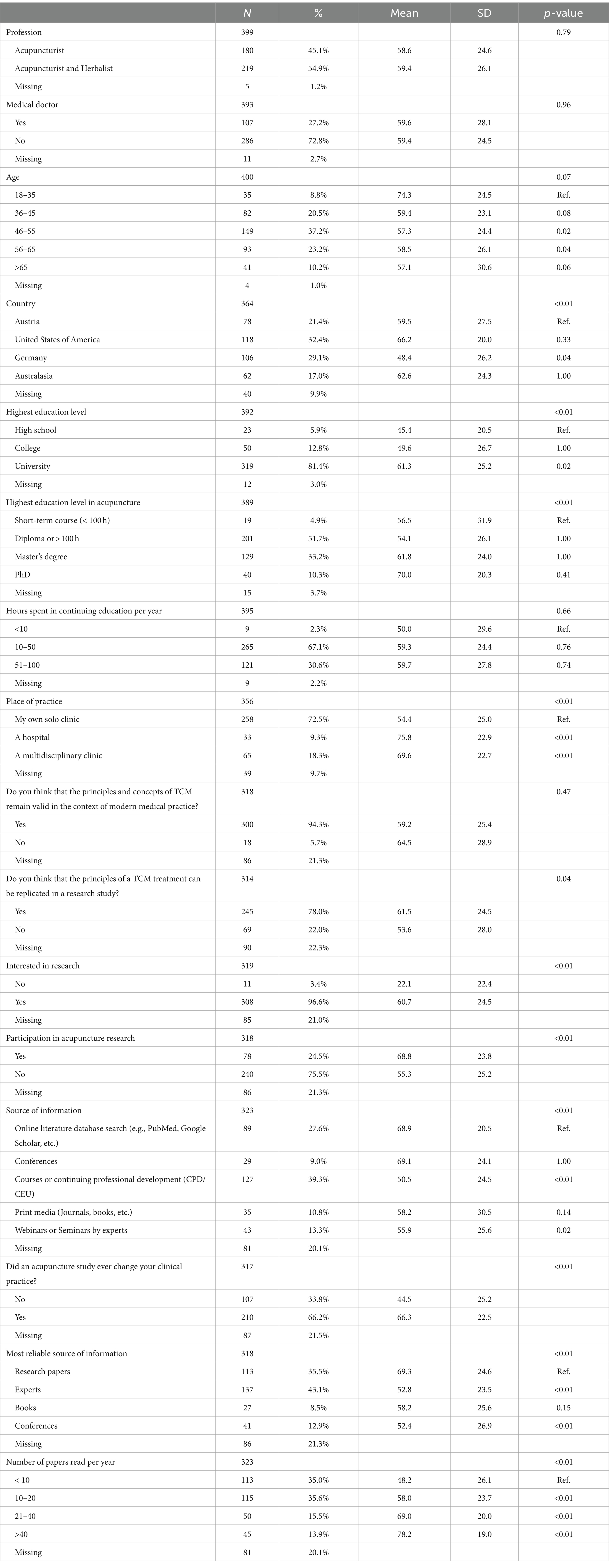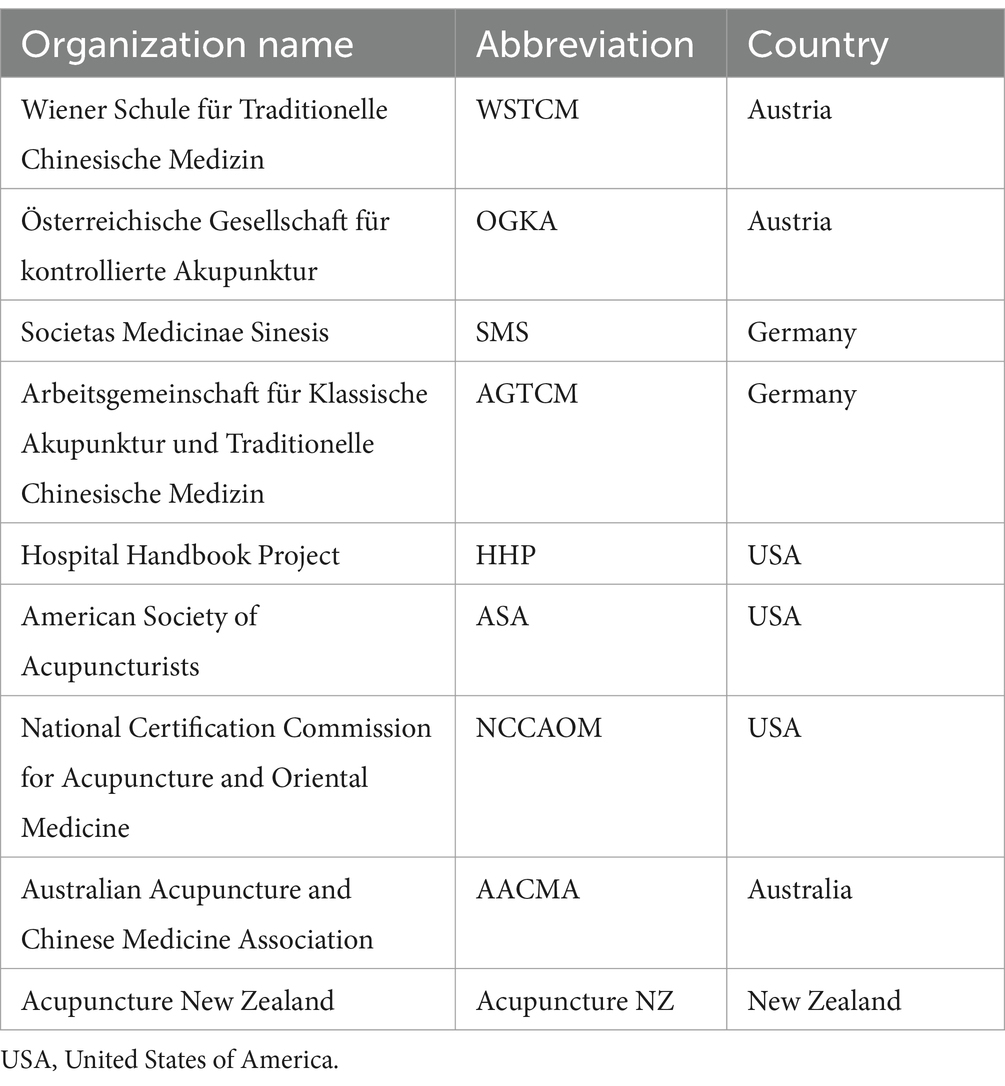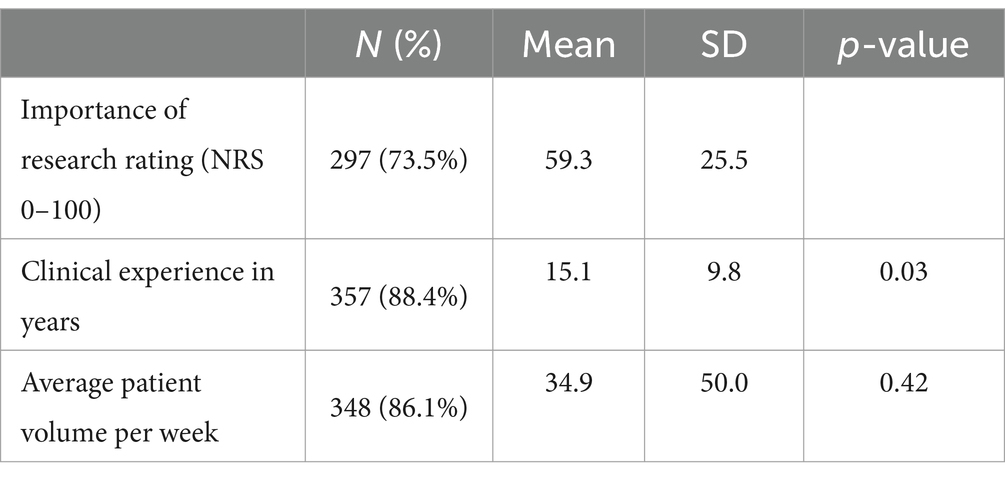- 1Department of Internal Medicine, Division of Oncology, Palliative Care Unit, Medical University of Graz, Graz, Austria
- 2Northern College of Acupuncture, York, United Kingdom
- 3School of Health and Society, Faculty of Education, Health and Wellbeing, University of Wolverhampton, Wolverhampton, United Kingdom
- 4NICM Health Research Institute, Western Sydney University, Penrith, NSW, Australia
- 5Translational Health Research Institute, Western Sydney University, Penrith, NSW, Australia
- 6Medical Research Institute of New Zealand (MRINZ), Wellington, New Zealand
- 7Translational Oncology, University Hospital of Augsburg, Augsburg, Germany
Background: Evidence-informed practice is crucial to perform safe and efficient health interventions. In recent years, the evidence base of acupuncture continuously increased leading to the integration of acupuncture into clinical guidelines by various leading medical associations worldwide. At the same time, recent studies showed that licensed acupuncturists are rarely utilizing scientific research to inform their practice.
Methods: This descriptive study using an online survey assessed the role of evidence-informed practice of acupuncturists in Austria, Germany, the United States of America, Australia, and New Zealand and aimed to determine critical factors relevant for promoting research literacy including demographical data, data about the clinical practice patterns, and the role and value of different information sources of traditional, complementary and integrative medicine (TCIM) practitioners.
Results: In total, 404 acupuncturists completed the online survey that included questions about demographic characteristics, the role and value of research in clinical practice, and details about the amount and type of continuing professional education. Univariate and multivariate analysis was used to determine significant predictors of the outcome variable “importance of research in clinical practice” (numerical rating scale, 0 to 100). The results showed that the majority of acupuncturists use certified courses as primary source of continuing professional education and value experts’ opinions as the most reliable source of information. Multivariate analysis showed that the importance of research is dependent on the interest in research, an interdisciplinary learning environment, and positive experiences with research including if an acupuncture study ever changed the clinical practice of practitioners.
Conclusion: Future educational programs should therefore focus on an interactive format aiming to promote skills to critically assess the value and practical use of research studies to improve the general practice of acupuncture.
1 Introduction
Evidence-informed practice is a fundamental principle in modern evidence-based medicine. It assures best clinical practice by balancing highest effectiveness and patient safety (1). To fulfill this, practitioners need the skills to critical evaluate and interpret research before translating it into clinical practice (2). However, one of the greatest barriers for the implementation of evidence-based practice in medicine, regardless of the medical discipline, is research literacy, the capability of health care personnel to critical appraise and interpret clinical research (3). Additionally, secondary factors including education level, time-issues, work-life balance, and accessibility of research articles are barriers to ongoing education and incorporation of research findings in their clinical practice (4–7).
In recent years, there has been a substantial amount of research on acupuncture and a focus on improving the evidence base for various conditions (8, 9). Currently, major medical associations suggest acupuncture for the treatment of various conditions, especially for the treatment of chronic pain (10, 11) and also pain management in oncology (12), which led to a change of health care policies promoting insurance coverage of acupuncture (12–18). Therefore, acupuncturists are hired increasingly by medical facilities to provide an overall integrative treatment in the United States of America (19). However, acupuncture is mostly taught and performed based on traditional medical systems rather than current scientific evidence according to a recent systematic reviews and surveys among acupuncturists in Norway, the United States of America, Australia and New Zealand (6, 13, 20, 21). This limits acupuncturists in reading and interpreting acupuncture research as most studies lack some key aspects of traditional theoretical frameworks, making them hard to reproduce for an acupuncturist trained only in traditional medical systems (22). A multitude of additional factors were reported by acupuncturists as reasons for not utilizing acupuncture research for their clinical practice, including time constraints and also not valuing peer-reviewed publications as the best source of information to inform clinical practice (6, 21).
Different strategies for promoting research literacy among healthcare personnel exist and show promising results including workshops, journal clubs, research fellowships, and formal university courses of either interactive and student-centered or teacher-centered formats. Among all educational strategies, an interactive and student-centered approach showed the best results for improving research literacy (3). However, any educational program will fail if healthcare personnel, including acupuncturists, are not willing to participate. Enhancing the understanding of relevance and value of research findings is the first step toward improving research literacy, as it can motivate practitioners to seek further education about research interpretation and external validity for use in clinical practice.
Currently, factors associated to the attitude of acupuncturists toward research are poorly understood. This multinational survey among licensed acupuncturists was designed to assess the importance of research for clinical practice, as well as possible influencing factors to improve our understanding of how practitioners may be motivated toward educational programs designed to improve research literacy.
2 Methods
2.1 Study design
We designed a descriptive study using an online survey. The primary outcome was to assess the importance and value of research in clinical practice of acupuncture. Therefore, an anonymous self-completion questionnaire was designed to collect data about the participating acupuncturists’ demographics, annual hours spent in continuing professional development (CPD), and both primary and most trusted source of information for their clinical practice. The study was approved by the local ethics committee (Ethics Committee of the Medical University of Graz, Austria; document number 34-432 ex 21/22).
2.2 Survey questionnaire and outcome measurement
For the primary outcome, we asked the respondents to rate the importance of research on a 0 to 100 numerical rating scale, where higher scores reflected greater importance of research for clinical practice. The questionnaire included open and closed questions in single-choice categorical response format. Demographical data describing the diversity of the participants included profession, age, place of living, education level, education in acupuncture, place of practice, experience in years, and average patient volume per week. Additional questions about the value of research in clinical practice included general interest in research, if a study ever changed their clinical practice, participation in acupuncture research, and number of research papers read per year. Participants were also asked if the principles of traditional Chinese medicine (TCM) remain valid in the context of modern medicine and if these can be replicated in a research study. The survey questionnaire was primarily designed by M.H. and S.G. using previous published surveys assessing the research literacy among acupuncturists (4, 6, 13, 23, 24). The final version of the questionnaire was reviewed by M.A. and M.P. Each survey item and its response categories are listed in Table 1.
2.2.1 Translation and piloting the questionnaire
The questionnaire was available in two languages, English and German. The first version was created in English and then translated to German by three native speakers (M.H. German, S.G. English, and external professional translator) using the forward-backward-translation process. After reviewing the final two versions, both versions were piloted by 10 German or English-speaking acupuncturists asking them to rate the understandability, readability, and user-friendliness of the questionnaire on a scale of one to 10 with higher scores indicating a better understandability, readability, or user-friendliness. Additionally, we offered the piloting acupuncturists a free-text field to provide additional suggestions on how to improve the questionnaire. The questionnaire showed good understandability and readability, requiring only minor orthographical and grammatical adaptions.
2.3 Participants
Acupuncturists were invited to participate in this study if they were 18 years or older, held a current license for acupuncture practice, and were currently living in Austria, Germany, the United States of America, Australia, and New Zealand.
2.4 Recruitment strategies
Professional organizations representing acupuncture and Chinese medicine were asked to distribute the survey-link on their social media channels and via email between October 2022 and December 2022. The survey was open from October 1st, 2022, to January 15th, 2023. The participating organizations are listed in Table 2. Before starting the survey, participants were asked to give their consent to participate and agree to the use of their provided data using the built-in e-consent tool of the Research Electronic Data Capture (REDCap) system (25, 26). The survey participants were not offered any type of incentives as a means to increase their willingness to participate or for compensation.
2.5 Data management and analysis
The survey data was collected and managed using the REDCap online survey and distribution tool hosted by the Medical University of Graz, Austria (25, 26). We then exported the data from the REDCap system to RStudio (“Ghost Orchid” Release, R version 4.0.3) (27). All variables with less than 30% missing data were included, and missing data was reported. Descriptive statistics included means, standard deviations (SD), or numbers and percentages. For univariable analysis of two groups, we used Student’s t-test or Fisher’s exact test, for more than two groups we used analysis of variance (ANOVA), Kruskal-Wallis-Test, or linear regression. The significance level was set at p < 0.05 and corrected using the Bonferroni correction in multiple testing. For multivariable analysis, we built a linear regression model using the importance of research rating as the outcome variable and all variables with a p-value of <0.1 in the univariable analysis as predictors. The final number of predictor variables for the regression model was based on an exhaustive search algorithm selecting the variables yielding the highest adjusted R-square value (28). We did not use imputation methods to replace missing data. All analyses and plotting were performed using R version 4.0.3 and the package “ggplot2” (27, 29).
3 Results
3.1 Demographics
In total, 43,695 acupuncturists were invited by the participating professional organizations, of which 742 respondents completed the questionnaire (response rate 1.7%). For further analysis, 404 questionnaires fulfilled the predefined criteria of less than 30% missing data and current place of living. The majority of respondents were not medical doctors (72.8%), had a license in acupuncture and herbal medicine (54.9%), were 46–55 years old (37.2%), completed an education on university level (81.4%), and a diploma or > 100 h course in acupuncture (51.7%). The responding acupuncturists had a mean clinical experience of 15.1 years (standard deviation [SD] 9.8) and a mean patient volume of 34.9 (SD 50.0) per week. The majority (72.5%) of acupuncturists work in their own solo clinic. Respondents were distributed evenly among countries with the highest proportion in the United States of America (32.4%). The demographical data and univariable analysis are summarized in Tables 1, 3.
Demographical data and univariate analysis results of “Importance of research rating” (NRS, range 0–100). SD, standard deviation; TCM, traditional Chinese medicine; Ref., reference.
3.2 Role of research in clinical practice
The mean of the importance of research in clinical practice rating was 59.3 (SD 25.5) in the total population (Table 3). Almost all respondents (96.6%) stated to be interested in acupuncture research but a lower proportion (66.2%) stated that research ever changed their clinical practice. Additionally, only 24.5% ever participated actively in acupuncture research. Most acupuncturists (35.6%) read 10–20 research papers per year but almost the same proportion (35.0%) read less than 10 papers per year. Overall, 94.3% of the responding acupuncturists think that the principles of TCM remain valid in the context of modern medical practice and 78.0% think that it is possible to replicate those principles in a research study (Table 2).
3.3 Informing clinical practice
To further educate themselves, acupuncturists primarily participate in certified courses (39.3%) and think experts are the most reliable source of information (43.1%). Performing a literature search in online databases like Pubmed or Google Scholar is the second most utilized way to gain knowledge (27.6%) and 35.5% also think that research papers are the most important source. Regarding time commitment, 67.1% spend 10–50 h per year for continuing education (Table 2).
3.4 Univariable analysis
Univariable analysis was performed using the importance of research rating as the outcome variable. Age (ANOVA, p = 0.07), country (ANOVA, p < 0.01), highest education level (ANOVA, p < 0.01), highest education level in acupuncture (ANOVA, p < 0.01), place of practice (ANOVA, p < 0.01), if TCM can be replicated in a research study (t-test, p = 0.04), interest in research (t-test, p < 0.01), participation in acupuncture research (t-test, p < 0.01), source of information (ANOVA, p < 0.01), if an acupuncture study ever changed the clinical practice of the acupuncturists (t-test, p < 0.01), most reliable source of information (ANOVA, p < 0.01), number of papers read per year (ANOVA, p < 0.01), and clinical experience in years (linear regression, ß = −0.32, p = 0.03) showed significant differences in how participants rated the importance of research for clinical practice (Table 2).
Additionally, variables with more than two outcome possibilities, a pairwise t-test was performed to determine factors that are significantly different to the reference group (first response category). All p-values were adjusted by Bonferroni correction for multiple testing. Statistical differences were found in the demographical data between age “18–35” (M = 74.3, SD = 24.5) and age “46–55” (M = 57.3, SD = 24.4, p = 0.02) and “56–65” (M = 58.5, SD = 26.1, p = 0.04), the country “Austria” (M = 59.5, SD = 27.5) and “Germany” (M = 48.4, SD = 26.2, p = 0.04), the highest education level “High school” (M = 45.4, SD = 20.5) and “University” (M = 61.3, SD = 25.2, p = 0.02), and place of practice “my own solo clinic” (M = 54.4, SD = 25.0) and “multidisciplinary clinic” (M = 69.6, SD = 22.7, p < 0.01) and “hospital” (M = 75.8, SD = 22.9, p < 0.01) (Figure 1).
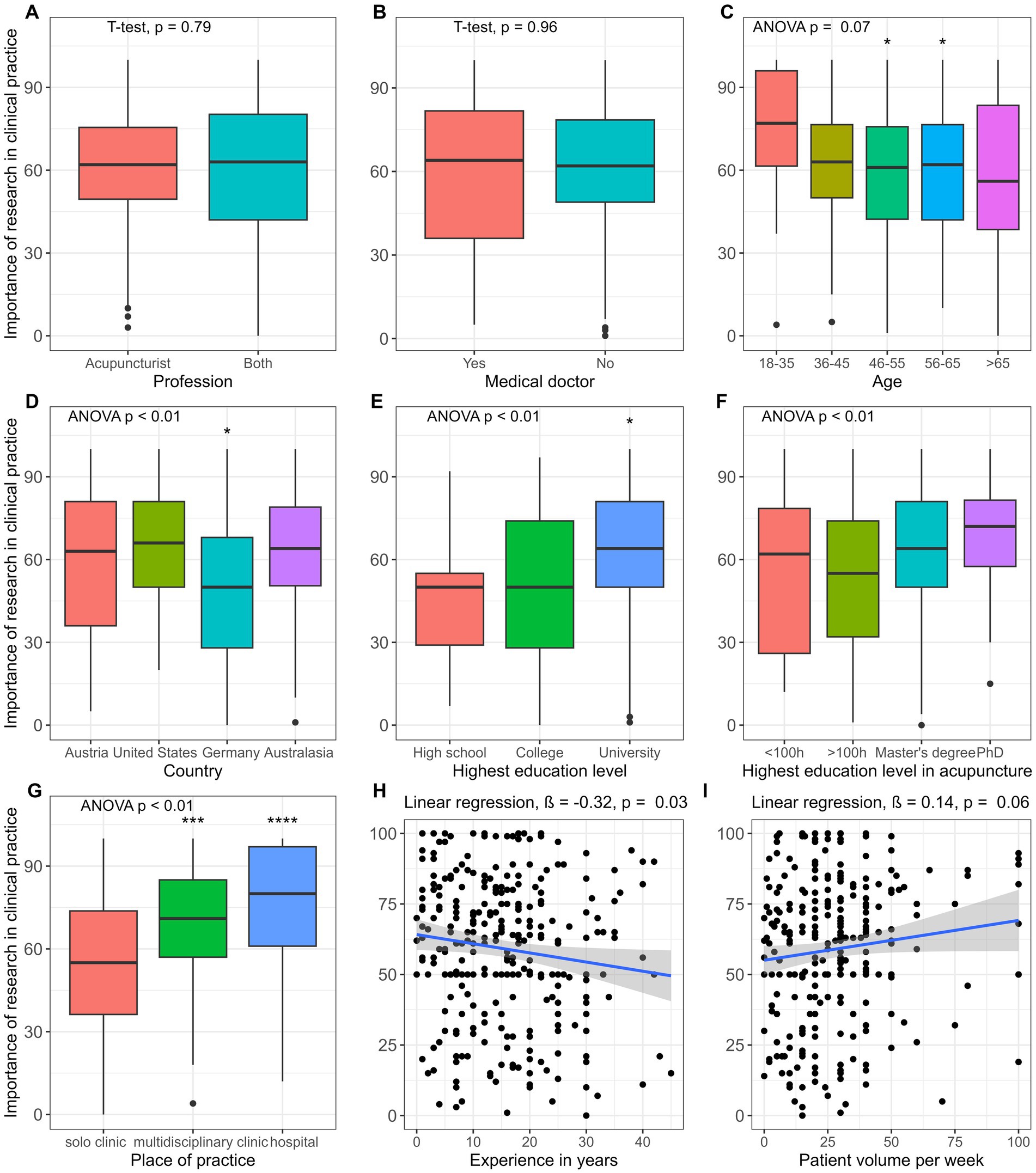
Figure 1. Univariable analysis of the importance of research in clinical practice by demographical data. (A) Profession, (B) Medical doctor, (C) Age, (D) Country, (E) Highest education level, (F) Highest education level in acupuncture, (G) Place of practice, (H) Experience in years, (I) Patient volume per week.
Additionally, numbers of papers read per year “<10” (M = 48.2, SD = 26.1) was significantly different to “10–20” (M = 58.0, SD = 23.7, p < 0.01), “21–40” (M = 69.0, SD = 20.0, p < 0.01), and “>40” (M = 78.2, SD = 19.0, p < 0.01) (Figure 2).
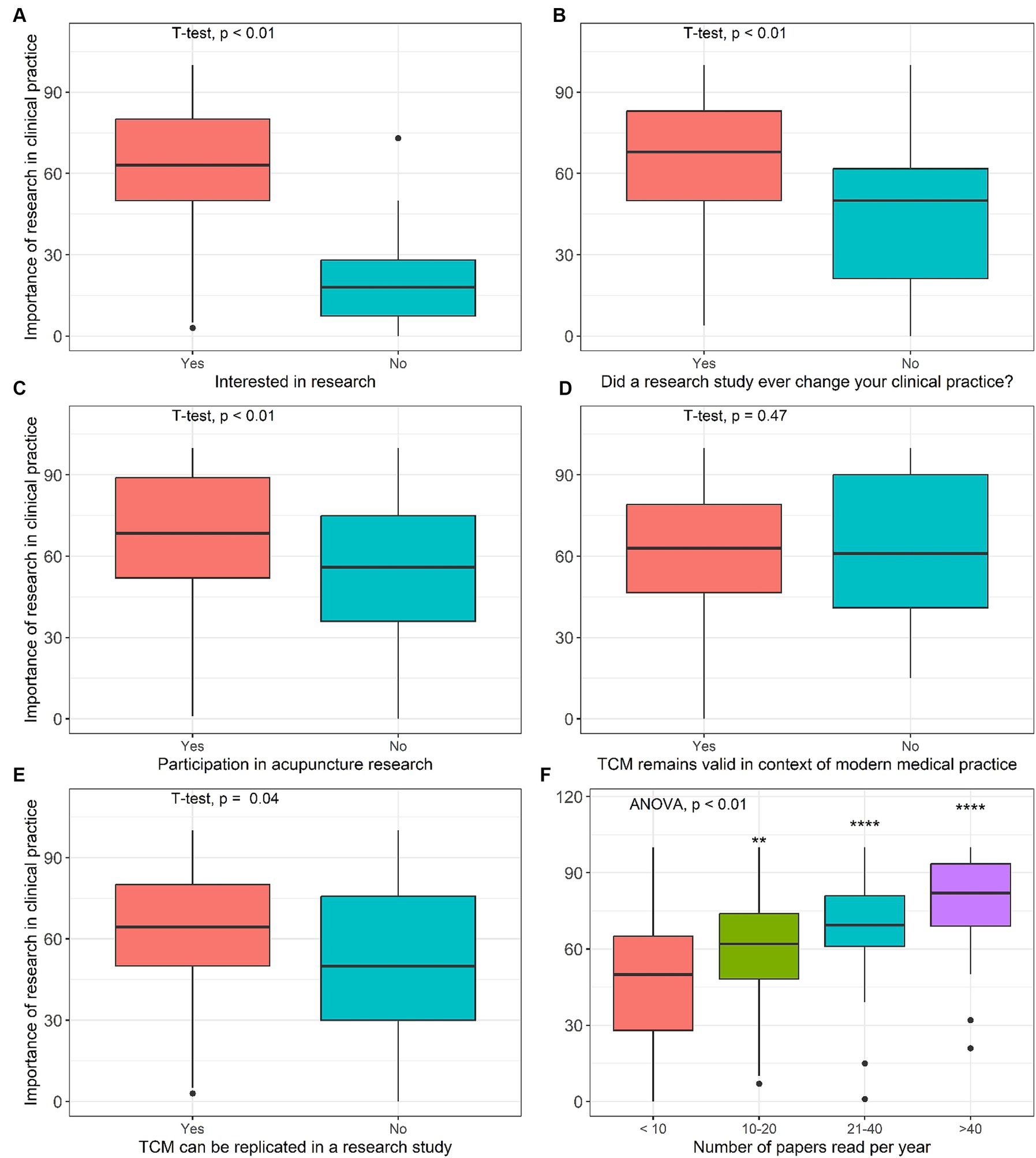
Figure 2. Univariable analysis of the importance of research in clinical practice by variables describing the value research. (A) Interested in research, (B) Dida research study ever change your clinical practice? (C) Participation in acupuncture research, (D) TCM remains valid in context of modern medical practice, (E) TCM can be replicated in a research study, (F) Number of papers read per year.
Finally, statistical differences were also found between the source of information “online database” (MD = 68.9, SD = 20.5) compared to “courses” (MD = 50.5, SD = 24.5, p < 0.01) and “webinars” (MD = 55.9, SD = 25.6, p = 0.02), and the most reliable source of information being “research papers” (MD = 69.3, SD = 24.6) compared to “experts” (MD = 52.8, SD = 23.5, p < 0.01) and “conferences” (MD = 52.4, SD = 26.9, p < 0.01) (Figure 3).
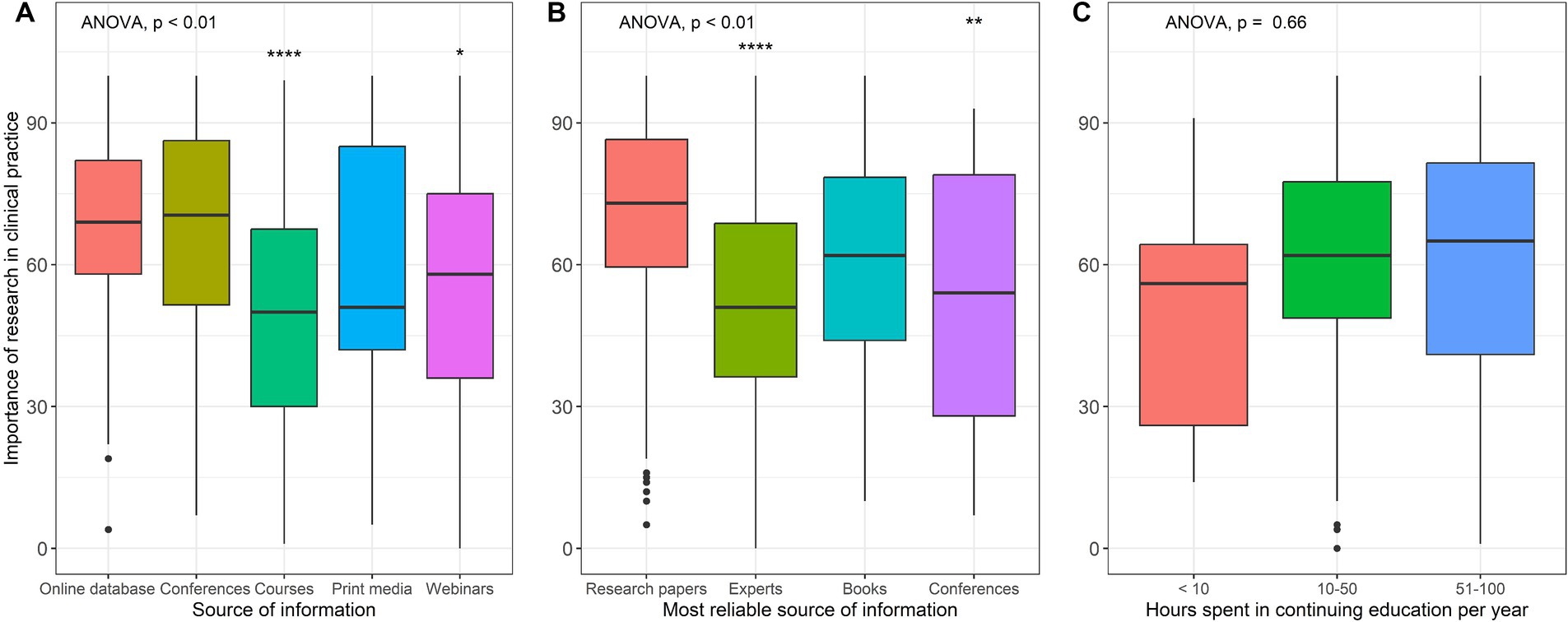
Figure 3. Univariable analysis of the importance of research in clinical practice by variables describing how practitioners inform their clinical practice. (A) Source of information, (B) Most reliable source of information, (C) Hours spent in continuing education per year.
3.5 Multivariable analysis
Based on the univariable analysis, all variables with a p-value less than 0.1 were included in the multivariable analysis. To build a model with best model fit, an exhaustive search for the final variable selection was performed, with the highest adjusted R-squared value. The resulting regression model had a good model fit explaining 38% of the variability (adjusted R-squared) with an overall significant regression (F[19, 241] = 9.24, p < 0.01). Further, the results showed that being interested in research (ß = 22.1, p < 0.01), reading more than 40 papers (ß = 18.2, p < 0.01) or 21–40 papers (ß = 10.9, p = 0.01) per year, if an acupuncture study ever changed the clinical practice (ß = 13.9, p < 0.01), practicing in a hospital (ß = 12.2, p = 0.01) or multidisciplinary clinic (ß = 7.9, p = 0.02), and attending conferences to inform the clinical practice of acupuncture (ß = 10.5, p = 0.03) was strongly associated to rating research as more important for clinical practice. On the other hand, using certified courses for CPD (ß = −7.1, p = 0.03) was negatively associated to the importance of research in clinical practice rating (Figure 4).
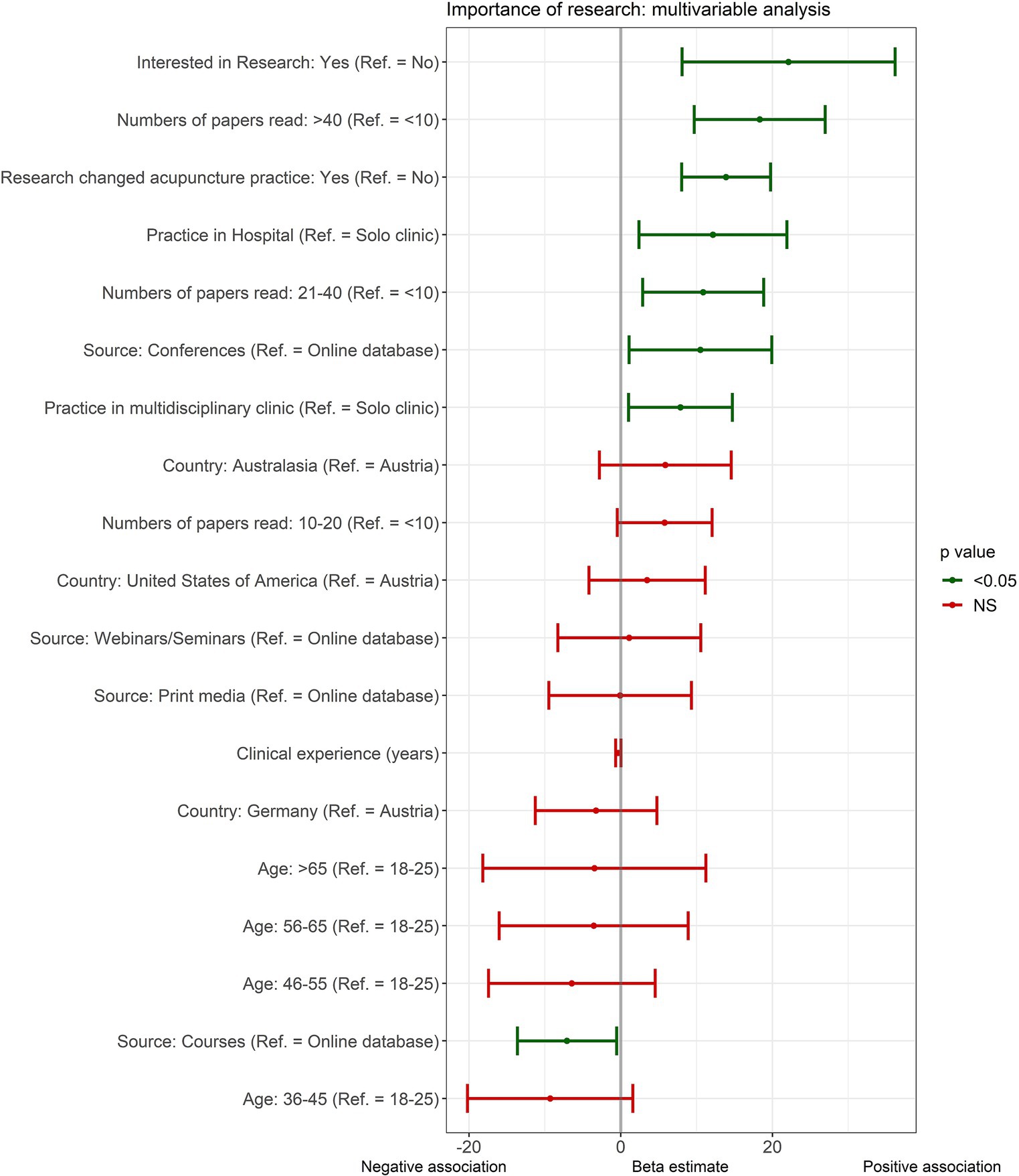
Figure 4. Multivariable analysis of factors associated to the importance of research in clinical practice. NS, Not significant; Ref., reference.
4 Discussion
Factors associated to a favorable attitude toward acupuncture research were identified in this large multinational survey among acupuncturists. While not surprising that acupuncturists rate research as more important for clinical practice when being interested in research or with the numbers of papers read per year, the most interesting finding was the independent prognostic effect of the place of practice, source of information, and if an acupuncture study ever changed the clinical practice of the respondents. However, it appears that current programs of acupuncture education commonly lack a focus on developing basic research skills including searching and interpreting adequate sources. We therefore outlined and discussed each of the identified factors below.
Overall, our identified factors could serve as basic principles for strategies that aim at promoting research literacy among acupuncturists. Previous studies identified interactive and activity-based learning as effective to improve the research literacy of healthcare personnel (3) and acupuncturists (6). Our results show a strong statistical association between the value of research and if an acupuncture study ever changed acupuncturists’ clinical practice. It is likely that positive experiences with research in clinical practice improve the interest and value of research in general. Emphasizing the practical value of acupuncture studies rather than lecturing theoretical principles of research methodology should be a core principle of future educational programs, which could be achieved by focusing on the critical evaluation and extraction of clinically useful information such as acupuncture points used and aspects of dosage regime, including treatment frequency and duration.
Further, interdisciplinary information exchange is another important factor that is associated to a higher value of research in clinical practice (3). This is especially highlighted by our results in the uni- and multivariable analysis showing conferences being positively and certified courses being negatively associated with the importance of research in clinical practice rating. Conferences are an important outlet for researchers to present, disseminate, and discuss their findings with attendees, whereas CPD courses are often held by experts in their field who approach acupuncture theory from a traditional angle of knowledge and are rarely evidence-informed in a modern sense (21). In general, future educational programs should not only incorporate more research findings to justify the use of acupuncture for certain conditions or treatment approach using the available scientific evidence, but should also facilitate interdisciplinary exchange through, for example, mandatory participation at acupuncture conferences as attendee or possibly presenter in poster sessions. For this purpose, acupuncturists can use data collected in their own clinic, accurately reflecting real-world acupuncture practice and outcomes, which they can also publish in dedicated Case Report journals, therefore simultaneously contributing toward informing future trial design and actively closing the loop of evidence-informed practice and practice-informed research (24).
Another example of how inter- and multidisciplinary environments predicted a higher research literacy are the implementation of acupuncturists in public health care facilities including hospitals and multidisciplinary clinics. Our results showed significant higher importance of research in clinical practice ratings of acupuncturists working in multidisciplinary clinics or hospitals compared to those working in their own solo clinic. Additionally, working in either of these settings were significant predictors of the importance rating in our multivariable analysis. In public healthcare facilities, essential requirements concerning evidence-informed practice are generally higher than in solo clinics, challenging acupuncturists to further educate themselves in research literacy skills (30). With the progressing implementation of acupuncture in public healthcare facilities, future educational programs should consider clinical internships in teaching hospitals as a possibility to foster multidisciplinary information exchange among acupuncture students and practitioners.
To the best of our knowledge, previous surveys assessing the attitude and role of research for evidence-informed practice among acupuncturists are rare and were on national level only, not allowing strong general conclusions or the assessment of cultural differences. Furthermore, these studies were of descriptive nature and did not use inferential statistical processes to quantify relationships (4, 6, 21, 23). However, the results of these studies complement our findings of research being underutilized as a source of information for clinical practice among acupuncturists. Practitioners mostly attend CPD courses (39.3%) to educate themselves further and value experts’ opinion as the most reliable source of information (43.1%). Using CPD courses as primary source of information was additionally unfavorably associated to valuing research as important for clinical practice. On the other hand, only 27.6% use online databases such as Pubmed or Google Scholar as primary source of information and 35.5% trust research papers the most according to our results. Dahle et al. and Graca et al. reported similar results for the incorporation of research findings in clinical practice for Norway and Australasia (39 and 27%, respectively) (6, 21). Additionally, reading more than 20 research papers per year was an independent predictor of a higher value of research for clinical practice in our sample. Another positive predictor was if acupuncturists ever participated in acupuncture research. Anderson et al. found that research literacy was positively correlated to research participation in faculty members of an oriental medicine college in the United States of America (23). However, this study was performed among members of a highly academic environment potentially explaining the positive correlation. Contrarily, our results showed a weak statistical association of the highest education level in general as well as in acupuncture to the importance of research rating. Further, adding these variables to our multivariable model did not increase the variability explained, suggesting a low relevance of the educational background for the value of research of acupuncture practitioners in clinical practice.
We did not identify any influence on the value of research of nation-level characteristics even though respondents in Germany showed significant lower importance of research ratings. This could be partially explained by the German educational system of acupuncturists, where it is not required to hold an academic degree in order to become a licensed acupuncturist. By contrast, in Austria only medical doctors are allowed to perform acupuncture, and in the United States of America and Australasia, acupuncturists need at least a Bachelor’s degree to become a licensed acupuncturist (31–35). German acupuncturists may therefore experience the least education in scientific principles, potentially explaining the low rating of the importance of research for their clinical practice. However, neither education in general, education in acupuncture, nor country of practice improved the variability explained in our multivariable analysis, suggesting once more no significant impact on the value of research. Additionally, the majority of respondents stated that the principles of TCM remain valid in the context of modern medicine and can be replicated in a research study, suggesting a positive attitude toward research in principle, but most acupuncturists seem to lack the skills to interpret and use available research findings in clinical practice, resulting in the low importance rating. Previous studies showed comparable results, confirming that the educational background had no direct influence on the research literacy, the critical assessment of scientific information, or protection against health misinformation (36).
There are certain limitations to this study including the overall low response rate to the survey. However, this is not uncommon in surveys using a convenience-sampling design and may be due to several factors, including low interest in actively participating in research (37). Additionally, some items of the survey have a moderately low response rate compared to others which needs to be considered when interpreting the results. Overall, the strengths of our study include the multi-national design allowing for more general conclusions for future educational programs and health care policy measurements aiming to improve the research literacy of acupuncturists.
In conclusion, the results provide first details about significant factors relevant for the research literacy of acupuncturists in western countries. Aiming for an interdisciplinary and interactive educational program may improve the value of research and facilitate the skills to implement evidence-informed practice among acupuncturists. Future educational programs should also be evaluated in terms of skills in research literacy and critical appraisal of research studies to enhance the quality of acupuncture training in general. Targeting the lack of evidence-informed practice will also help to further implement acupuncture in public health care systems through generally improving the acceptability by balancing the interventions effectiveness and patient safety.
Data availability statement
The raw data supporting the conclusions of this article will be made available by the authors, without undue reservation.
Ethics statement
The studies involving humans were approved by Ethics Committee of the Medical University of Graz, Austria. The studies were conducted in accordance with the local legislation and institutional requirements. The participants provided their written informed consent to participate in this study.
Author contributions
MH: Conceptualization, Data curation, Formal analysis, Investigation, Methodology, Project administration, Software, Validation, Visualization, Writing – original draft, Writing – review & editing. SG: Conceptualization, Formal analysis, Investigation, Methodology, Project administration, Resources, Supervision, Validation, Writing – original draft, Writing – review & editing. SB: Formal analysis, Project administration, Supervision, Writing – review & editing. GH: Formal analysis, Supervision, Validation, Writing – review & editing. MA: Methodology, Supervision, Validation, Writing – review & editing. MP: Methodology, Resources, Supervision, Validation, Writing – review & editing.
Funding
The author(s) declare that no financial support was received for the research, authorship, and/or publication of this article.
Conflict of interest
The authors declare that the research was conducted in the absence of any commercial or financial relationships that could be construed as a potential conflict of interest.
Publisher’s note
All claims expressed in this article are solely those of the authors and do not necessarily represent those of their affiliated organizations, or those of the publisher, the editors and the reviewers. Any product that may be evaluated in this article, or claim that may be made by its manufacturer, is not guaranteed or endorsed by the publisher.
References
1. Al-Jundi, A, and Sakka, S. Critical appraisal of clinical research. J Clin Diagn Res. (2017) 11:Je01–je5. doi: 10.7860/JCDR/2017/26047.9942
2. Brody, JL, Dalen, J, Annett, RD, Scherer, DG, and Turner, CW. Conceptualizing the role of research literacy in advancing societal health. J Health Psychol. (2012) 17:724–30. doi: 10.1177/1359105311425273
3. Hines, S, Ramsbotham, J, and Coyer, F. The effectiveness of interventions for improving the research literacy of nurses: a systematic review. Worldviews Evid-Based Nurs. (2015) 12:265–72. doi: 10.1111/wvn.12106
4. Armour, M, Betts, D, Roberts, K, Armour, S, and Smith, CA. The role of research in guiding treatment for Women's health: a qualitative study of traditional Chinese medicine acupuncturists. Int J Environ Res Public Health. (2021) 18:834. doi: 10.3390/ijerph18020834
5. Aziz, Z, Jet, CN, and Abdul Rahman, SS. Continuing professional development: views and barriers toward participation among Malaysian pharmacists. European J. Soc. Behav. Sci. (2013) 4:45–55. doi: 10.15405/ejsbs.2013.1.6
6. Graca, S, Betts, D, Roberts, K, Smith, CA, and Armour, M. The changing clinical landscape in acupuncture for women’s health: a cross-sectional online survey in New Zealand and Australia. BMC Complement. Med. Therap. (2022) 22:94. doi: 10.1186/s12906-022-03576-3
7. Jiandani, M, Bogam, R, Shah, C, Prabhu, S, and Taksande, B. Continuous professional development: faculty views on need, impact and barriers. Natl J Integr Res Med. (2015) 7:43–75. https://nicpd.ac.in/ojs-/index.php/njirm/article/view/1368
8. Guo, J, Pei, L, Chen, L, Chen, H, Gu, D, Xin, C, et al. Research trends of acupuncture therapy on cancer over the past two decades: a bibliometric analysis. Integr Cancer Ther. (2020) 19:153473542095944. doi: 10.1177/1534735420959442
9. Ma, Y, Dong, M, Zhou, K, Mita, C, Liu, J, and Wayne, PM. Publication trends in acupuncture research: a 20-year bibliometric analysis based on pub med. PLoS One. (2016) 11:e0168123. doi: 10.1371/journal.pone.0168123
10. Qaseem, A, Wilt, TJ, McLean, RM, Forciea, MA, Denberg, TD, Barry, MJ, et al. Noninvasive treatments for acute, subacute, and chronic low Back pain: a clinical practice guideline from the American College of Physicians. Ann Intern Med. (2017) 166:514–30. doi: 10.7326/M16-2367
11. NICE. Chronic pain (primary and secondary) in over 16s: assessment of all chronic pain and management of chronic primary pain. National Institute for Health and Care Excellence: Guidelines. London: National Institute for Health and Care Excellence (NICE) (2021).
12. Mao, JJ, Ismaila, N, Bao, T, Barton, D, Ben-Arye, E, Garland, EL, et al. Integrative medicine for pain Management in Oncology: Society for Integrative Oncology–ASCO guideline. J Clin Oncol. (2022) 40:3998–4024. doi: 10.1200/JCO.22.01357
13. Abrams, D, McCulloch, M, Cohen, M, Liaw, M, Silverman, D, and Wilson, C. A survey of licensed acupuncturists in the San Francisco Bay Area: prevalence of treating oncology patients. Integr Cancer Ther. (2018) 17:92–8. doi: 10.1177/1534735416684946
14. Bower, JE, Bak, K, Berger, A, Breitbart, W, Escalante, CP, Ganz, PA, et al. Screening, assessment, and Management of Fatigue in adult survivors of Cancer: an American Society of Clinical Oncology clinical practice guideline adaptation. J Clin Oncol. (2014) 32:1840–50. doi: 10.1200/JCO.2013.53.4495
15. National Comprehensive Cancer Network. (2023). Cancer-Related Fatigue (Version 2.2023). Available at: https://www.nccn.org/professionals/physician_gls/pdf/fatigue.pdf
18. Medicare. (2023). Acupuncture: Medicare, United States government. Available at: https://www.medicare.gov/coverage/acupuncture
19. Miller, DW, Roseen, EJ, Stone, JAM, Gardiner, P, Olson, J, Rosen, S, et al. Incorporating acupuncture into American healthcare: initiating a discussion on implementation science, the status of the field, and stakeholder considerations. Glob Adv Health Med. (2021) 10:216495612110425. doi: 10.1177/21649561211042574
20. Lu, Z, Moody, J, Marx, BL, and Hammerstrom, T. Treatment of chemotherapy-induced peripheral neuropathy in integrative oncology: a survey of acupuncture and oriental medicine practitioners. J Altern Complement Med. (2017) 23:964–70. doi: 10.1089/acm.2017.0052
21. Dahle, ML, and Alræk, T. Implementing evidence into clinical practice. A survey amongst Norwegian acupuncturists. Eur J Integr Med. (2023) 59:102234. doi: 10.1016/j.eujim.2023.102234
22. Hughes, JG, Lewith, G, Mac Pherson, H, Witt, CM, Cummings, M, and Fisher, P. Assessment of the quality of reporting in studies of acupuncture for patients with cancer using the STRICTA guidelines. Acupunct Med. (2019) 37:223–7. doi: 10.1136/acupmed-2017-011592
23. Anderson, BJ, Kligler, B, Taylor, B, Cohen, HW, and Marantz, PR. Faculty survey to assess research literacy and evidence-informed practice interest and support at Pacific College of Oriental Medicine. J Altern Complement Med. (2014) 20:705–12. doi: 10.1089/acm.2014.0138
24. Graca, S, and Citkovitz, C. From bench to bedside and Back again: developments in the evidence-informed practice (and practice-informed research) of acupuncture. J Integrat Complement Med. (2022) 28:613–7. doi: 10.1089/jicm.2022.0630
25. Harris, PA, Taylor, R, Minor, BL, Elliott, V, Fernandez, M, O'Neal, L, et al. The REDCap consortium: building an international community of software platform partners. J Biomed Inform. (2019) 95:103208. doi: 10.1016/j.jbi.2019.103208
26. Harris, PA, Taylor, R, Thielke, R, Payne, J, Gonzalez, N, and Conde, JG. Research electronic data capture (REDCap)—a metadata-driven methodology and workflow process for providing translational research informatics support. J Biomed Inform. (2009) 42:377–81. doi: 10.1016/j.jbi.2008.08.010
27. Team RC. (2020). R: a language and environment for statistical computing. R foundation for statistical Computing.
28. Nambury, SR, Reyhan, B, Jack, EE, and Paul, FF. Methodology review: estimation of population validity and cross-validity, and the use of equal weights in prediction. Appl Psychol Meas. (1997) 21:291–305. doi: 10.1177/01466216970214001
30. Upton, D, and Upton, P. Knowledge and use of evidence-based practice of GPs and hospital doctors. J Eval Clin Pract. (2006) 12:376–84. doi: 10.1111/j.1365-2753.2006.00602.x
31. Bährle, RJ, and Bährle, RJ. Heilpraktiker/Heilpraktikergesetz In: Praxisrecht für Therapeuten: Rechtstipps von A bis Z. Berlin: Springer (2011). 75–8.
32. Fan, AY, Stumpf, SH, Faggert Alemi, S, and Matecki, A. Distribution of licensed acupuncturists and educational institutions in the United States at the start of 2018. Complement Ther Med. (2018) 41:295–301. doi: 10.1016/j.ctim.2018.10.015
33. Ijaz, N, and Boon, H. Evaluating the international standards gap for the use of acupuncture needles by physiotherapists and chiropractors: a policy analysis. PLoS One. (2019) 14:e0226601. doi: 10.1371/journal.pone.0226601
34. Lin, K, and Tung, C. The regulation of the practice of acupuncture by physicians in the United States. Med Acupunct. (2017) 29:121–7. doi: 10.1089/acu.2017.1235
36. Nagler, RH, Vogel, RI, Rothman, AJ, Yzer, MC, and Gollust, SE. Vulnerability to the effects of conflicting health information: testing the moderating roles of Trust in News Media and Research Literacy. Health Educ Behav. (2023) 50:224–33. doi: 10.1177/10901981221110832
Keywords: evidence-informed practice, acupuncture, educational programs, public health, continuing professional development
Citation: Huemer M, Graca S, Bitsche S, Hofmann G, Armour M and Pichler M (2024) Assessing the role and impact of research in clinical practice among acupuncturists in western countries: a multinational cross-sectional survey. Front. Med. 11:1331184. doi: 10.3389/fmed.2024.1331184
Edited by:
Devyani Misra, Beth Israel Deaconess Medical Center and Harvard Medical School, United StatesReviewed by:
Joanna Dietzel, Charité University Medicine Berlin, GermanyDina Gaid, Memorial University of Newfoundland, Canada
Copyright © 2024 Huemer, Graca, Bitsche, Hofmann, Armour and Pichler. This is an open-access article distributed under the terms of the Creative Commons Attribution License (CC BY). The use, distribution or reproduction in other forums is permitted, provided the original author(s) and the copyright owner(s) are credited and that the original publication in this journal is cited, in accordance with accepted academic practice. No use, distribution or reproduction is permitted which does not comply with these terms.
*Correspondence: Matthias Huemer, bWF0dGhpYXMuaHVlbWVyQG1lZHVuaWdyYXouYXQ=
 Matthias Huemer
Matthias Huemer Sandro Graca
Sandro Graca Sarah Bitsche1
Sarah Bitsche1 Mike Armour
Mike Armour Martin Pichler
Martin Pichler